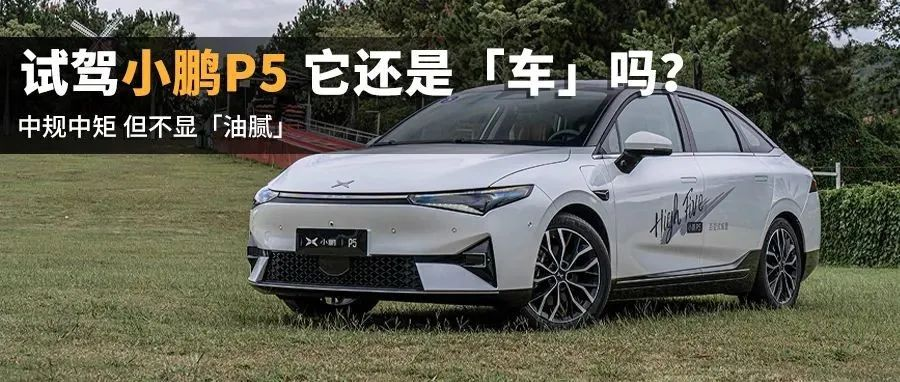Introduction to XPeng P5
Following the release of G3 and P7, XPeng has launched a new heavyweight product– P5.
When it comes to XPeng P5, what do we generally discuss? It might be the world’s first mass-produced lidar, urban NPG, the versatile third living space, or the current strongest intelligent cabin hardware and software combination, but most likely it won’t be about how it drives.
Apparently, in the age of intelligent electric vehicles, driving performance as a “car” itself is no longer the most concerned point for people. However, in this test drive, I still hope to establish a comprehensive understanding of XPeng P5.
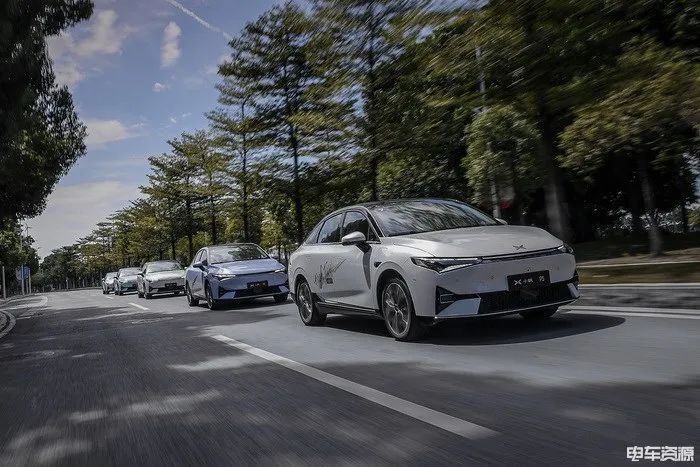
Quick facts about XPeng P5
- XPeng P5 has six models available: 460G, 460E, 550G, 550E, 550P, and 600P, with three battery versions to choose from: 55.9 kWh (lithium iron phosphate, NEDC range of 460 km); 66.2 kWh (ternary lithium, NEDC range of 550 km); 71.4 kWh (ternary lithium, NEDC range of 600 km), with corresponding price ranges between 157,900 – 223,900 yuan.
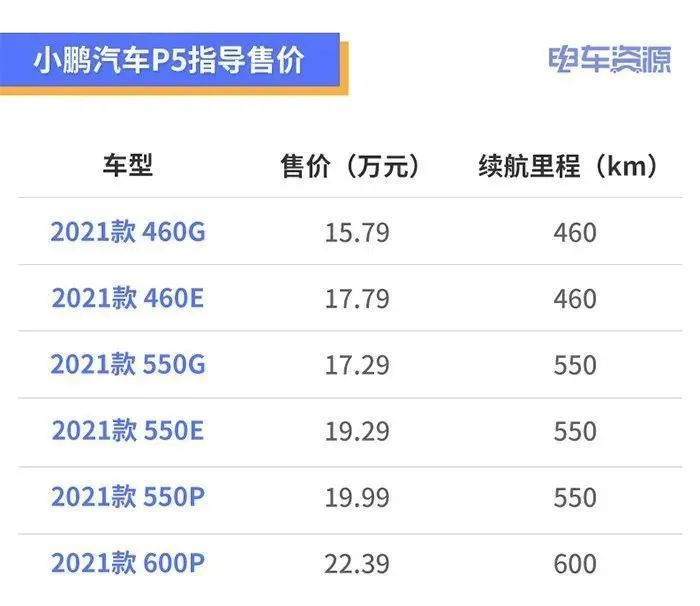
-
XPeng P5 has a new model naming system, with “P” representing XPILOT 3.5 (lidar) driving assistance capability, “E” representing XPILOT 3.0, “N” representing XPILOT 2.5, and “G” representing a car without any driving assistance features.
-
All models come with the same permanent magnet synchronous motor, with maximum power of 155 kW and maximum torque of 310 N·m, with an official 0-100 km/h acceleration time of 7.5 seconds.
-
The entire system comes with Qualcomm Snapdragon 8155 vehicle-grade chip, running on Xmart OS 3.0, with a full-scenario intelligent voice system, supports up to 120 seconds of continuous conversation, instant voice response, and semantic interrupt, etc.
Mediocre but not “greasy”
In fact, no matter from the appearance, vehicle positioning, or matched power, XPeng P5 is not a car that particularly emphasizes driving performance. However, with a 155 kW electric motor and 310 N·m torque, placed in such a compact car, its actual power level has surpassed most gasoline cars using 1.5T engines (like Honda Civic which is emissions compliant with China V).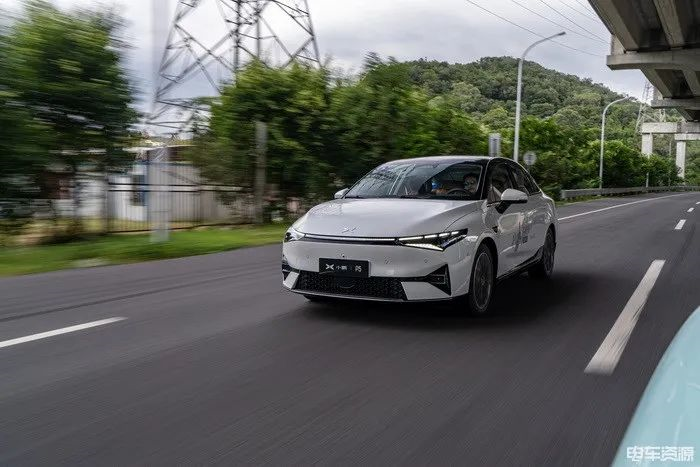
The official 0-100 km/h acceleration time is 7.5 seconds, but thanks to the characteristics of the electric motor, the initial acceleration of XPeng P5 is much stronger than that of a gasoline-powered vehicle. Although its ability to accelerate at high speeds is relatively weakened, it is definitely not “sluggish”. (Note: the evaluation in this article is based on the model equipped with 18-inch tires).

The driving mode, energy recovery and steering assistance can all be freely adjusted in three levels, which are not directly related to each other. The intensity gradually increases, making it very easy to understand. After a few adjustments, you can easily find the setting that best suits you.
However, it should be pointed out here that the energy recovery of XPeng P5 is very fast. Although it is relatively linear, it almost immediately intervenes as soon as you release the pedal without any 0.x second delay buffer. Even someone like me who often drives an electric car needs a longer adaptation time. Overall, it is less easy to control than the X-Pedal single pedal mode, which has a stronger correlation with the throttle pedal.

The chassis part is a combination of the more conventional front McPherson independent suspension and rear torsion beam non-independent suspension. But overall, the tuning level is still good, providing a comfortable riding experience. The initial setting is relatively soft and has a certain level of sophistication. It effectively isolates small road vibrations and can handle large undulations on highways softly enough. However, there are slightly more up-and-down aftershocks, especially in the rear seats.

The steering wheel naturally has limited road feel, but the overall direction is relatively accurate. The virtual space in the middle position is not too large, and the body follow-up is good. However, because the suspension is relatively soft, the lateral swing during rapid lane changes is more obvious. In addition, the steering wheel can only be adjusted up and down, and does not support front and rear adjustment, which is not too friendly for taller drivers.
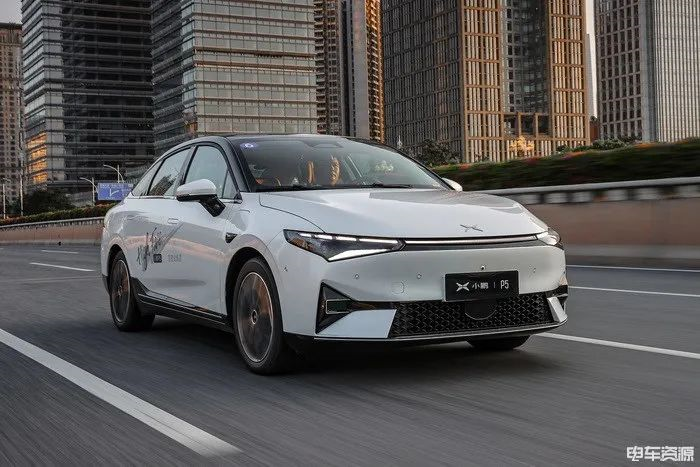 The sound insulation part of the car is highly praised. The test drive car is equipped with 18-inch wheels and Michelin Harmony 3st tires (the 550E and above versions only need to pay an additional 3000 yuan or exchange points, while the standard version comes with 17-inch Pirelli tires). These are very familiar and comfortable quiet tires that help suppress road noise, are not very picky about road conditions, and greatly improve the overall driving quality. It is recommended that users with sufficient budget choose them.
The sound insulation part of the car is highly praised. The test drive car is equipped with 18-inch wheels and Michelin Harmony 3st tires (the 550E and above versions only need to pay an additional 3000 yuan or exchange points, while the standard version comes with 17-inch Pirelli tires). These are very familiar and comfortable quiet tires that help suppress road noise, are not very picky about road conditions, and greatly improve the overall driving quality. It is recommended that users with sufficient budget choose them.

Overall, XPeng P5 is an average level of self-owned brand car that costs around 150,000 yuan. Considering that pure driving performance is not its selling point, as a pure household car mainly for easy driving, such performance is completely acceptable.
Static Review
Is XPeng P5 really ugly? When P5 was first released, many friends called it “XPeng pill”. Even today, people’s evaluation of the appearance of XPeng P5 is still polarized, after all, its too homely style is far from the science fiction and sporty P7. But after a day of contact, I actually feel that XPeng P5 looks more and more pleasing to the eye; it is just that it is not the kind of car that will turn heads on the road.

XPeng P5 has a size of 4808/1840/1530 mm (length/width/height) and a wheelbase of 2768 mm. The body is already relatively high in the same level of models. Furthermore, the black border around the bottom of the car also raises the visual center of gravity. In fact, if that black border could be changed to the same color as the body, it would be much better. I tried it out:
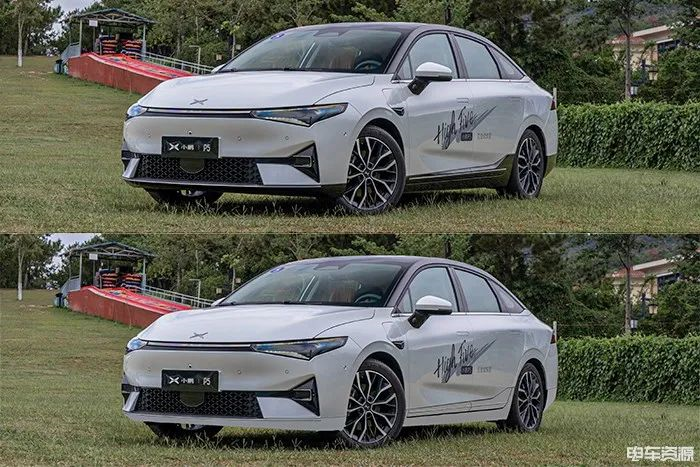
P5 adopts the family-style X Robot Face design, and the lights of the Light Sword 3.0 also integrate the “X” element into a one-piece headlight.

The 550P and 600P models are equipped with two vehicle-level LiDARs from DJI Luov. The point cloud density is effectively equivalent to 144 lines. The detection distance for targets with 10% reflection rate can reach 150m, and the front side dual arrangement enhances the field of view to 150°. Additionally, there are:
- 9 auxiliary driving perception cameras
- 4 360° surround-view cameras
- 5 millimeter-wave radar
- 12 ultrasonic radars
- NVIDIA Xavier chipWith the addition of high-precision maps, this XPILOT 3.5 system can fully meet the requirements of the most challenging NGP city roads.
There is a relatively high risk of collision for the laser radar in this position, but fortunately, it can be fully covered by 360° surround view and front/side radar. Pay special attention when driving normally. Even if it is only lightly touched, the function may be disabled due to changes in the height/angle of the laser irradiation. Re-calibration is not a simple task.
The rear part of the car is also equipped with a one-piece LED taillight that is similar to the front part. The overall design is also round and simple.
Unlike the P7, the P5 is equipped with an independent trunk switch button.
Next, let’s take a look at the interior. Although positioned as a lower-end model, the interior of the XiaoPeng P5 is still of good quality. The door panels and the top of the center console are made of textured soft plastic, while the lower parts are wrapped in leather.
The entire lineup is equipped with the third-generation Qualcomm Snapdragon digital cockpit platform, which uses the latest 8155 automotive-grade chip, has 12 GB of RAM and 128 GB of storage, and is equipped with a neural network processor NPU with AI deep learning capabilities. The performance of the CPU and GPU has increased by 8.5 times and 20 times respectively compared to the previous generation.
The vertically arranged center console screen is 15.6 inches, with a thin bezel and a suitable tilt angle. The richness of the car’s functions, the smoothness and ease of use of the system, and the recognition and accuracy of the full-scenario intelligent voice are all top-level among all intelligent cars currently available.
Due to the short test driving process, a more detailed evaluation cannot be given at present. Interested friends can stay tuned for our upcoming “Car Infotainment System Experience” article about XiaoPeng P5.
Due to cost limitations, the XiaoPeng P5 does not come with the Denon sound system like the P7, but it still retains the slow-rising high-frequency speaker in the front row when powered on, which adds to the sense of ceremony.
The large screen at the back is equipped with intelligent fragrances that can be optionally installed for the E and P models, included in the intelligent sleep space package (¥12,000, standard for the 600P model). If not installed, this space will be a storage compartment connected on the left and right.

The NAPPA leather seats that are included in the intelligent sleep space package are much softer and have good lateral support compared to the P7. However, they do not come with lumbar support, and the shoulder position (the location of the backrest’s central decoration strip) is relatively pronounced. When sitting normally, the head is not easy to rest directly on the headrest. It would be better if it could have an adjustable headrest.
In addition, only the seat cushion supports heating and ventilation, and not the backrest, which reduces the overall utility.

The wings of the front headrests can be manually clamped, which cannot be seen in the same level of models.
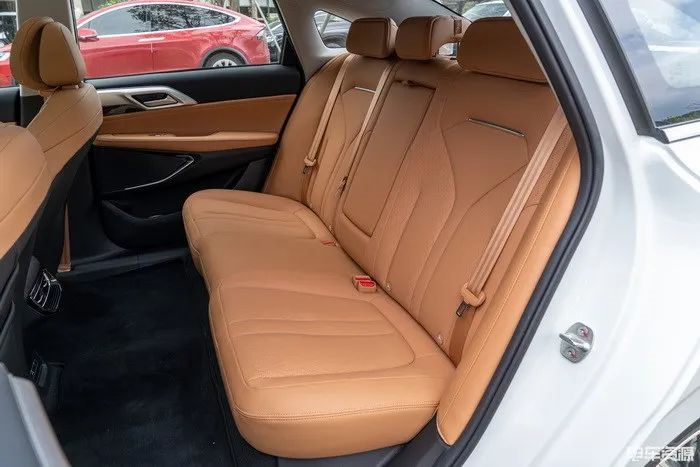
Friends who have slept in the back seat of a car should understand that sometimes they want to adjust their posture slightly, but once they move their head, they cannot rest it on the headrest anymore. They can only slide down a little and lie flat, which is not only uncomfortable but also unsafe (the seatbelt will squeeze). The headrest of the P5 rear seat is the widest I have seen in all the cars so far, which largely solves this problem.

The spacious seating space of the XPeng P5 is one of its major advantages. When adjusting the seat to its lowest position, at a height of 174 cm, there is still a space of one fist and four fingers from the sun visor. If it is opened, the space will be even larger.
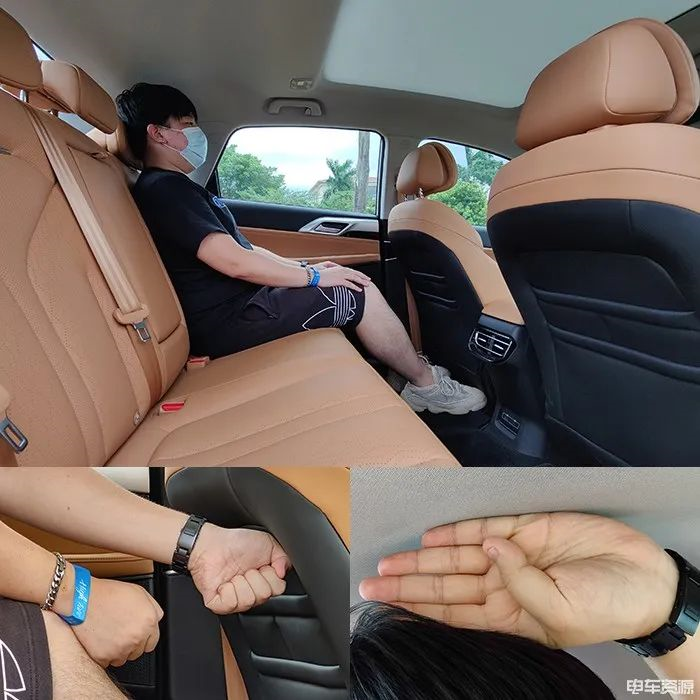
The rear seat cushion is higher than the front seat, and the space is equally outstanding, which has basically reached the level of some midsize cars. Moreover, the central platform has only very slight protrusions, and with a foot pad, it can be almost ignored.
 Remove the front headrest and the front seats of P5 can be folded down with one button. With the customized inflatable mattress, cushions and more, your P5 instantly turns into a camper.
Remove the front headrest and the front seats of P5 can be folded down with one button. With the customized inflatable mattress, cushions and more, your P5 instantly turns into a camper.

Below the rear air vent, there are two USB ports, one of which is USB Type-C with an output power of up to 60W.
If you choose the Smart Living Space Package (including the intelligent sleep space, costing 20,000 yuan, only 8,000 yuan for the 600P model), in addition to a customized projector and projection screen, you can also get a rear refrigerator with a large capacity (reducing the trunk volume to 360L). There is no pressure to put 2L of Coke and a bunch of barbecue ingredients in it.

The temperature of the refrigerator can be switched between -6°C, 0°C, and 6°C on the central control panel. You can also set the duration of continuous refrigeration after the power is turned off (up to 24 hours). However, there is only a beverage limit in the lateral direction of the refrigerator. If you only put a few bottles of drinks, they will slide forward at the first brake, making all kinds of “dududu” noises while driving. The function is very good but can be further improved in detail, such as adding a non-freezing soft non-slip mat.
Conclusion
Although there is still some time for the official delivery of XPeng P5, according to the reserved information, over 90% of the orders have chosen the high-end 550P configuration, and more than 50% of users have also chosen the Smart Sleep Space.
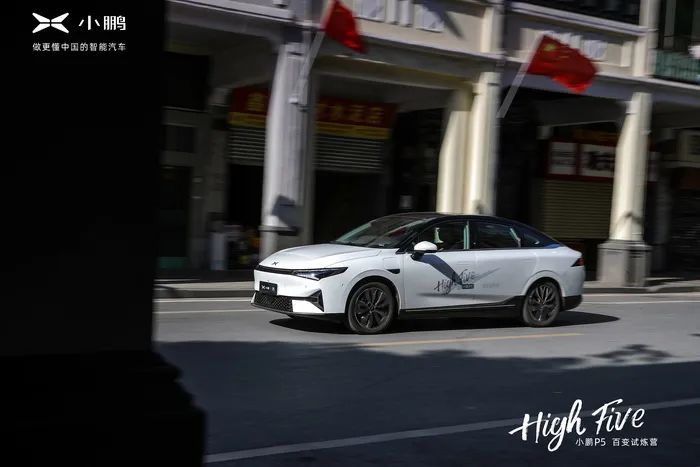
As with the styling, the comments of XPeng P5’s worthwhileness are also polarized. After all, from the perspective of the power, endurance, and space performance of a new energy vehicle, its price is not cheap. But this can only be said to be the basic capability of a “car”. If you consider XPeng P5’s powerful intelligent cockpit and auxiliary driving, do you still think it’s expensive?
Overall, users who choose this-level car models hope for comprehensive features, and XPeng P5 indeed satisfies both the practical and comfort needs of family users, and the entertainment and intelligence needs of young users, which is not easy.
This article is a translation by ChatGPT of a Chinese report from 42HOW. If you have any questions about it, please email bd@42how.com.
